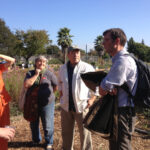Part III: Local Resilience through Collapse
Economic resilience = creating highly resilient structures which will enable our local communities to survive, hopefully with a relative level of peace and security.
Like anything in the work of trying to further this transition, we need to consider the appropriate scale. In Part II we examined what several thinkers had to say about our Big Picture economy, yet most of us have little-to-no ability to make an impact at that scale. Most of us who are working within the Transition movement are doing so because we understand that at the grassroots scale, we do have considerable ability to make a difference.
Thus in this section we will leave the macro-econ transformation to those who have ability to teach and influence at that level, and we will turn to the grassroots level, where most of us are working. What can we do, at the grassroots scale, to address economics, and to build local resilience?
Our first task is to create a shadow economic, social and even technological structure that will be ready to take over as the existing system fails.
— David Ehrenfeld
Hopkins selected the Ehrenfeld quote for the margins of the Transition Handbook. When I first read it, the quotation was quite alarming. “Whoa, we’re not setting out to take over the world!” I thought.
But as I contemplated it, I realized that what Ehrenfeld was talking about was creating the safety net — creating highly resilient structures which will enable our local communities to survive, hopefully with a relative level of peace and security.
It’s perhaps easier to see how this safety net approach applies in the case of our food systems: By building up local, organic urban agriculture, we are better prepared for the point at which peak oil and climate change choke our massive‑scale agribusiness and cause it to crumble and fail.
In our economic systems, too, we must create the safety net that will be ready in place as the existing system coughs, sputters, or fails. As all of this economic contraction unfolds – as globalized corporations struggle and panic, as today’s power elite are tumbled and replaced, as we all ride the wild rollercoaster – we, the little guys, will still need to feed our children, maintain a roof over our heads, and maintain a relative degree of order within our local hometowns.
If you freeze and worry at the thought of the economy, it’s no wonder, because we’ve made a horrible mess of it in recent years. We’ve made it hideously complex, to all of our detriment, plus most of us have become completely dependent consumers.
It might help to remind you of the simplicity, that what economics really boils down to is the sum total of transactions between people. Think of a simple barter transaction: You know your neighbor and he knows you. You swap some homegrown zucchini for a few backyard chicken eggs. That’s an economic transaction, full of vitality, life, and interdependence.
At this most basic scale, we feel secure: there will be food on the table. When we become producers — particularly, producers of the basic stuff of everyday living — we will always have something to exchange.
The trapeze artist doesn’t carry the safety net in her back pocket. She doesn’t tie it to her body. It isn’t part of her, nor integrated into her polished routine. It’s separate and distinct, out of the spotlight, ready to catch her when she falls.
To be a functional safety net, the shadow structure woven by our Transition Initiatives must develop independently from and parallel to the mainstream system. This is the ultimate reason why our local Transition Initiatives cannot be lead by today’s politicians or government.
Link to more thoughts on government and the Transition movement


